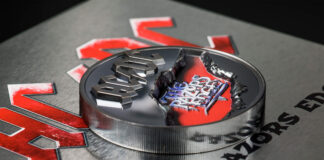120 years ago the world’s first rollercoaster whose loop did not endanger the lives of its passengers opened at Coney Island. CIT commemorates this with a coin featuring a rollercoaster on BOTH sides(!) in ultra-high relief on the coin edge thanks to smartminting©.

One side depicts the vertical loop of a roller coaster, in which a car with three passengers dares to complete the inversion. In the loop LOOP / THE / LOOP – 1901/2021, in the left field 120th ANNIVERSARY, in the right field CONEY ISLAND, N.Y.
The other side depicts the mirror-image of the exact same loop with passengers; inside the portrait of Queen Elizabeth II by Ian Rank Broadley (signature IRB below the neck). Around it the legend ELIZABETH II – 5 DOLLARS – COOK ISLANDS

1901: The world’s First Safe Rollercoaster Opens
In 1901, the world’s first rollercoaster whose loop did not endanger the lives of its passengers opened at Coney Island. Due to the circle-shape design of their loops, all previous roller coasters had exposed passengers to such high g-forces that they risked serious injuries of their cervical spine. When Loop the Loop started, the competing Flip Flap Railway with a loop of 25 feet (= 7.62m) produced in its passengers g-forces of incredible 12g. For comparison: today, the world’s highest roller coaster is Kingda Ka in New Jersey with a height of 139m, it exposes its hedonistic passengers to 4.5g for a short amount of time; the frontal impact of a car at 45 km/h amounts to 16g.
The technological solution to the question of how to reduce this figure was replacing the circular shape with an elliptical design in teardrop shape, which was first used by engineer Edwin Prescott to build Loop the Loop. However, even though Coney Island was a perfect location for this new attraction, Loop the Loop did not become a commercial success. Only a few people were willing to pay 10 cents to expose themselves to the still uncomfortable ride through the loop. As early as in 1910, Loop the Loop was dismantled.
Nevertheless, Loop the Loop became an icon of the American entertainment industry. CIT commemorates this epochal roller coaster on its 120th anniversary with a coin, which is a technological masterpiece, too. Thanks to smartminting© technology, the roller coaster is depicted on BOTH sides(!) in ultra-high relief on the coin edge. Prior to the development of enhanced smartminting© technology, such a coin was downright impossible. The coin was minted by B. H. Mayer’s Kunstprägeanstalt, Munich.
Further information about the coin is available on the CIT website.
If you are curious what Coney Island looked like around 1900 (and you will also see the Loop-the-Loop!), browse through this online coffee table book: “Coney Island – The People’s Playground: A Souvernir Picture Book.”
Do you want to climb into today’s rollercoaster on Coney Island? Come on, get in and hold on: The Thunderbolt!






